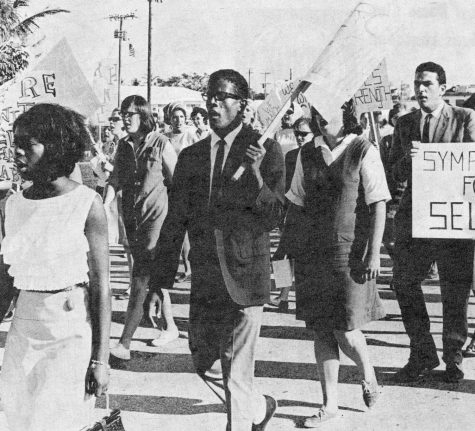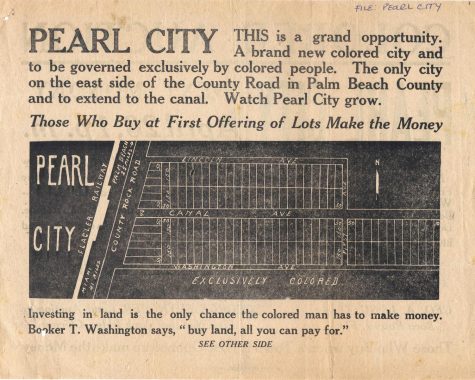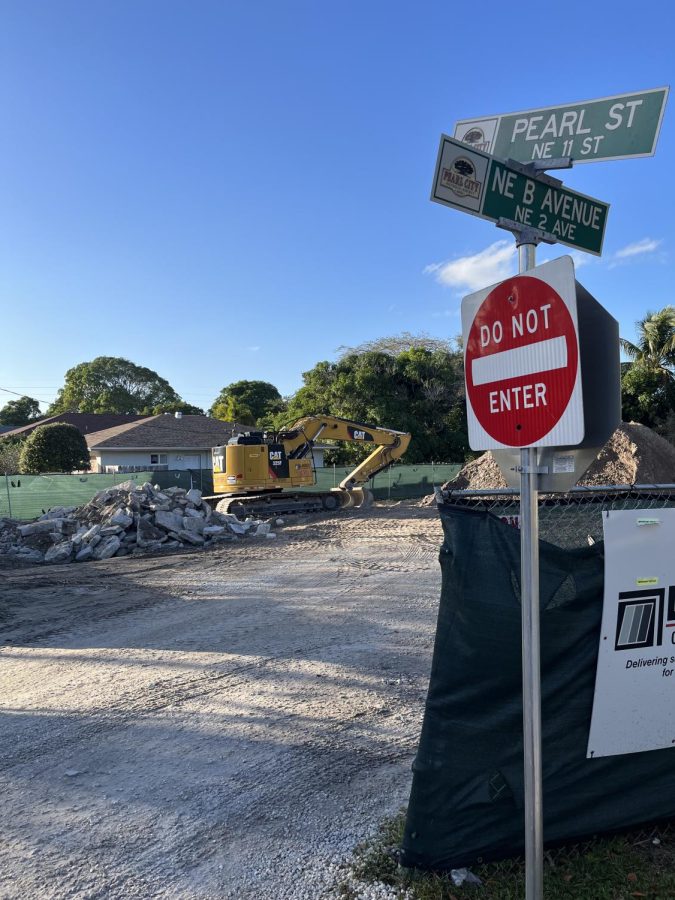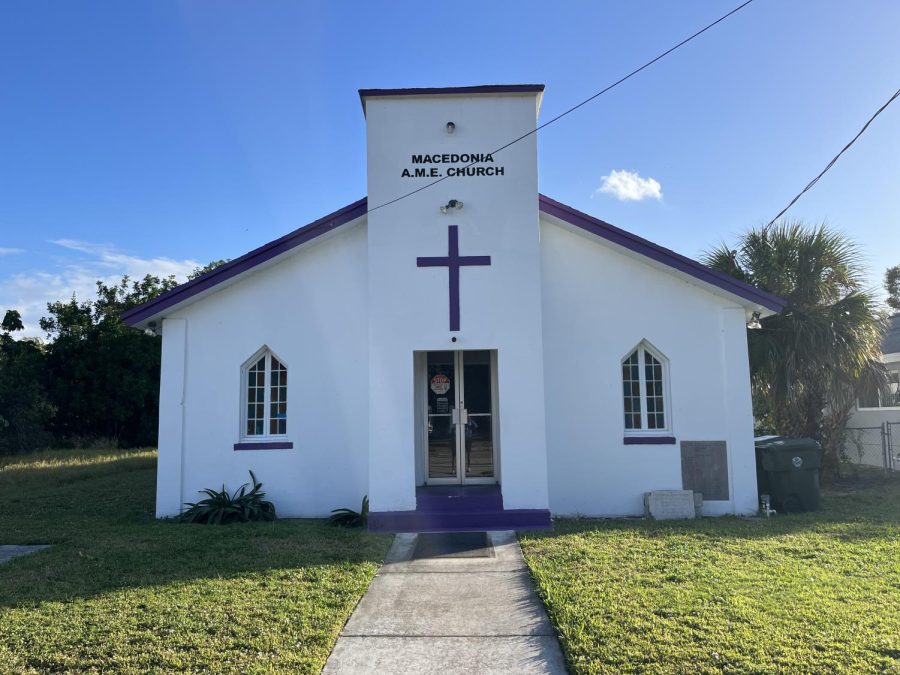Pearl City: 108 years of resilience
Long before FAU, even before the city itself was founded, Boca Raton was home to a vibrant, all-Black community which still stands to this day.
Lot in Pearl City that has already began demolition and reconstruction.
February 9, 2023
Editor’s note: Candace Cunningham was initially misidentified, as of Feb. 10 it has been corrected.
Today, the most notable stop along Old Dixie Highway, which cuts directly through the heart of Boca Raton, is the brand-new, $56 million Brightline station that opened last December. But long before that was built, the busiest stop along that road was a vibrant, all-Black community that predates the city itself.
Nestled between what is now Federal and Dixie Highway, and directly South of what is now Glades Rd., Pearl City was an all-Black neighborhood established in 1915, 10 years before Boca Raton Itself had been incorporated, for the African-American sharecroppers working on the many farms in the area at that time.
“It is the oldest neighborhood,” said Candace Cunningham, history professor at FAU. “It’s older than Boca Raton, the city, and it’s the only historically Black neighborhood, that’s very much part of the importance.”
It was originally proposed by George Long, an associate of railroad tycoon Henry Flagler, so workers wouldn’t have to make the daily trek from Deerfield Beach to the pineapple farms where they worked—which is where the neighborhood is suspected to get its name, Hawaiian Pearl Pineapples.
After the community was approved, small parcels of land—ones that were smaller and more expensive than those offered to white families—went up for auction for a minimum down payment of $5. One by one, families began to move in.
Though it wasn’t an immediate process, Pearl City’s three avenues, Lincoln, Canal, and Washington, were dotted with several family homes, primarily built in the long, thin “shotgun” style that was popular around the South in that era. The homes were small, humble abodes, most consisting of just a few rooms, with resident’s own crops and livestock often kept between each other.
Although it never grew considerably large in number, the neighborhood eventually blossomed into a self-sufficient community, independent of the white society they were ostracized from. Within a few years of its establishment, Pearl City eventually developed its own infrastructure; several businesses, a school, even entertainment, such as multiple dance halls, or “juke joints” –as they were referred to.
“They were mom-and-pop type stores, but it became its own little commercial area,” said Susan Gillis, curator of the Schmidt Boca Raton Historical Museum. “They had to, because the Black citizens were not welcomed in the white areas.”
The community grew to become very tight knit, often gathering together at the neighborhood’s juke joints, or at the beach to enjoy eating freshly caught sea turtle, which was a frequently eaten meal at the time.
Marie Hester, one of 14 grandchildren of Pearl City’s pioneers Will and Belle Demery, called growing up in the community “a family affair.”
“It was like a village,” remembers Hester, who was born in the family home in Pearl City. “Everyone watched out for each other, we had to.”
However, what really binded the neighborhood together is the two churches that Pearl City is built both literally and figuratively around: Ebenezer Missionary Baptist and Macedonia African Methodist Episcopal; both of which still stand today.
In 1985, the Boca Raton Historical Society published an oral history on Pearl City in which an original resident of the neighborhood, Lois Dauphus Martin, detailed the importance of the two churches.
“Well, we were all close because you had like two churches in here, Ebenezer Baptist and Macedonia,” remembered Martin. “The first and third Sunday you went to Ebenezer, the second and fourth you went to Macedonia, and that’s how we operated for years and years. [On Sundays] one church would close down and we would all be at the other church.”
Aside from being their place of worship, the churches were often the host of community gatherings and became a symbol of pride and community to the neighborhood.
Cunningham, who’s been heavily involved in the community, including helping organize a photo exhibit about Pearl City at the Boca Raton Art Museum, spoke to the importance of the churches to Pearl City.
“When you think historically to the role of Black churches in the Black community, they are not only centers of religion, but they are also centers of culture and where African-Americans can sort of openly discuss social issues,” said Cunningham. “The Black church was often times the only spaces that were owned and operated exclusively by Black Americans. So that meant African-Americans could organize and openly discuss issues without the same sort of fear of repercussions.”
Ebenezer and Macedonia weren’t the only source of pride in their community. Residents took great pride in the fact that their neighborhood was situated east of the railroad that runs directly through Boca Raton.
At the time, all-Black neighborhoods were usually built on the opposite side of train tracks as a way of physically, and symbolically, separating them from the rest of society, just as the all-Black communities in neighboring Fort Lauderdale and Palm Beach were. Pearl City, however, was not, and its residents took great pride in that fact.
“We prided ourselves on living on the east side of the railroad track,” said Hester.
Despite the state of the rest of the South at the time, even at the height of segregation there was never much tension between the residents and the adjacent white neighborhoods, because the communities remained to themselves.
“They were very friendly and as far as I know, there were no problems to speak of,” wrote Pearl City resident, Louise Dolphus Williams. “Because you stayed in your community and you did your thing and they stayed in their community and they did their thing, as far as I know.”
Because there wasn’t much negative interaction between themselves and the white communities, residents of Pearl City didn’t take much part in the Civil Rights Movement swarming the nation in the 1960s.
“We really weren’t aware of all the things that were happening. Mostly because we didn’t have a television. We had a radio but we didn’t have freedom of the radio. So we really had no knowledge of it,” said Hester.
The Civil Rights Movement wasn’t a hot topic of conversation either. Hester added that her first time really learning any knowledge of Black history was on a trip to Washington D.C. as an 18-year-old.
“That was the most education I had received on civil rights and Black history,” she recalled.

Some residents of Pearl City did, however, take part in the movement at least once. In 1965, students of Marymount College in Boca Raton, now Lynn University, gathered with residents of Pearl City to march in response to the “Bloody Sunday” marches led by civil rights trailblazer Rev. Martin Luther King Jr. in Selma, Ala.
Though they sit just over a mile away from each other, FAU’s ties to Pearl City remained loose until a sociology professor decided to share the neighborhood’s story to the rest of the world.
In 1985, Dr. Arthur Evans, who passed away in 2018, conducted a series of interviews with generational residents of the neighborhood, and shared the interviews in two publications. One of which was the Spanish River Papers, the other was a book Evans helped author titled “Pearl City: A Black Community”—which is the source of most of the society’s historical information on the community and all of their quotes from its residents.
Both Cunningham and Gillis credit Evans’ research with being one of the most important factors in keeping the stories of Pearl City alive.
“He did really important work in terms of helping to preserve that history and helping actually create a historical narrative that we wouldn’t have otherwise,” said Cunningham.
It was also Evans’ work that played a part in inspiring Cunningham to do her own research on the community, which took the form of 12 oral histories she authored about Pearl City.
“What I wanted to do with my oral histories is get a sense of what has happened since its founding, and also get a sense of what is enabling citizens of Pearl City to retain their property and sense of community,” said Cunningham in an interview with PBS. “I think the importance of collecting those stories is that they’re now available for prosperity. But also, we know what those residents want in their future.”
In the wake of Evans and Cunningham’s research in Pearl City, student organizations on FAU’s campus have become heavily involved with the community and the several events dedicated to its preservation.
The FAU Chapter of the National Association for the Advancement of Colored People (NAACP) has frequently done work in the community recently, and in years past. Chapter President Hannah Laguerre frankly described it as “heartwarming” to be able to help give back to Pearl City.
“It’s also so fulfilling because kids today don’t seem very interested in history. So being able to show there are still some who are interested in their history and giving back is so important,” said Laguerre.
FAU’s NAACP has taken part in several events benefitting Pearl City within years. This past June, with the help of Ebenezer Baptist, the NAACP held a youth rock-painting event for children. More recently, they assisted the community host their annual parade and community event in celebration of Martin Luther King Jr. Day.
Other campus organizations have also been involved in the community, such as the Black Student Union, who hosted a field day for the children of Pearl City this past Labor Day.
In addition to the charity that’s been done, there’s been a lot of effort put into the preservation of Pearl City, from both the residents and outside entities.
Because of the neighborhood’s designation as a local historic district, the area can never be redeveloped for commercial use. However, homes in Pearl City, some of which have been passed down for generations, are being bought out for demolition and reconstruction into modern residences. Federal designation, however, would add further protections from gentrification.
“Historical designation from the city essentially means that an area will maintain its characteristic as a residential area,” said Cunningham. “What that residential area looks like, and quite frankly, who is benefitting from that area could alter.”

The fight to maintain Boca Raton’s oldest neighborhood hasn’t wavered though.
In 1994, five members of Ebenezer Baptist helped found the Developing Interracial Social Change of Boca Raton (D.I.S.C.), a local non profit dedicated to “promoting justice in the community” according to their website. Now with Hester as President and with the help of several other groups, the organization has been leading the push to have Pearl City designated as a national historic district.
Hester explains that the federal government focuses on the stories when making a decision.
“I think we will receive the designation,” she said. “We have turned in the last of the information. We are just waiting to hear from them now.”
Gillis and Boca Raton historical society have been recently focusing their efforts on saving the Fountain family home. Built in 1925 and the oldest original home in Pearl City, the Fountain home is one of the last remaining physical pieces of history that we have left of the neighborhood, but has fallen into disrepair.
Residents don’t plan on stopping their fight to make Pearl City a federally recognized historic district. Nor do they plan on leaving the community that many of their ancestors built and lived in for over a century, anytime soon.
This unwavering sentiment was described perfectly by Martin.
“They have tried their darndest to get us out of here,” she said. “They have told us a million times that this is our choice property and for you all to be living on it when you could sell it for commercial and make all this money off of it, but what do we say to them? This is home.”
Editor’s note: This story is in the UP’s latest issue that can be found physically on the distribution boxes around campus or digitally through our Issuu page.
Cameron Priester is the Sports Editor for the University Press. For information regarding this or other stories, email cpriester2020@fau.edu or tweet him @PriesterCameron.







